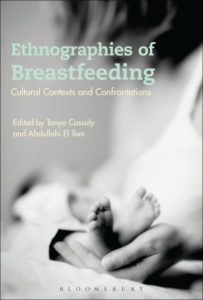Reviewed Book
Ethnographies of Breastfeeding: Cultural Contexts and Confrontations. Tanya Cassidy and Abdullah El Tom, eds., London: Bloomsbury, 2015, 255 pp.

Ethnographies of Breastfeeding is a strong contribution to the growing scholarship on the anthropology of breastfeeding. Tanya Cassidy and Abdullahi El Tom have brought together a breadth of chapters on milk sharing, milk banking, wet nursing, and infant feeding, encompassing topics such as HIV, surrogacy, gender, mother–infant bonding, and the naturalist discourse of breastfeeding. The collection focuses on contemporary issues related to breastfeeding and lactation in five continents, all the while highlighting the complex cultural situatedness of these experiences and controversies.
The purpose of this volume is to look globally at “the crisis circumstances of when a mother’s own breastmilk is not available” (p. xiii). This focus differs significantly from previous scholarship and publications. While anthropologists have individually considered aspects of risk, wet nursing, milk sharing, milk banking, and using infant formula, this compilation is the first to holistically consider different aspects of “crises” in lactation, while simultaneously comparing case studies from so many countries and cultures—from Brazil and the United States, to England, Ireland, France, Italy; to Bukino Faso, the Sudan, and Malawi; and to India and Australia.
Across the diversity and depth of the chapters, the volume highlights how local contexts affect specific experiences, while also emphasizing the role of globalization on these experiences and policies. For example, many chapters refer to the World Health Organization’s recommendation that all women exclusively breastfeed for their baby’s first six months of life, and that women continue breastfeeding for two years or more. Illustrating the different ways that this recommendation is implemented locally and understood by mothers, families, communities, and health care professionals in varying contexts is eye-opening, especially in places where HIV infections are disproportionately high, or where human milk is seen as a medical substance with the potential to be commercialized. Consequently, most of the authors illustrate the complexities of women’s experiences, as well as their individual agency in these situations. This volume is, therefore, an important addition not only to breastfeeding scholarship but also to historical and contemporary anthropological literature on reproduction, women, health, food security, and children.
While all of the chapters consider alternatives to explicit mother–child breastfeeding, including milk sharing, milk banking, and wet nursing, two chapters focus on infant feeding as it relates to HIV. Matthews (Chapter 9) focuses on the public health guidelines for infant feeding and HIV in Malawi, including their implementation and their ethical implications. Conversely, Desclaux and Alfieri (Chapter 8) highlight women’s strategies for HIV prevention, as they relate to breastfeeding, in Burkino Faso.
Most chapters place a heavy emphasis on the experiences of lactating, bonding, and how breastfeeding and lactation affect and are affected by social relationships. These social relationships include those of mothers with their infants, as well as with fathers, in-laws, milk donors, and health care professionals. One of the chapters in which such relationships are particularly highlighted is El Tom’s chapter (Chapter 7) on wet nursing among the Berti in northern Darfur, Sudan. His chapter highlights some of the complexities in the understandings of Islamic teachings on milk sharing and wet nursing, as well as his own personal account of having a “milk brother.” Another chapter focused on social relationships that is particularly unique is that of Reddy et al. (Chapter 10). Their focus on Indian gestational surrogates’ breastfeeding and bonding, as well as the desire of some commissioning mothers to induce breastfeeding, adds a depth of knowledge and attention to an area that is often neither discussed nor considered in the breastfeeding and surrogacy literature.
One weakness of this volume is that no chapter focuses on queer (lesbian or trans) experiences of lactating, or accessing alternative forms of human milk. This is a topic that is increasingly gaining attention both in popular culture and within professional health organizations, and thus is relevant to the scope of the book. That said, Palmquist’s chapter considers these experiences in its discussion of “Demedicalizing Breastmilk” (Chapter 2) noting that “milk sharing enables … emergent identities and [the creation] of novel expressions of caregiving that unsettle the notion that breastfeeding and feeding breastmilk is … strictly a womanly art” (p. 43). Since few anthropologists study queer experiences of lactation, this acknowledgment that not all experiences of breastfeeding are “womanly” or feminine was an important addition to the book.
Given that few anthologies are available that focus on breastfeeding, let alone with a focus on crisis, this volume is valuable. It has the potential to engage readers who are not typically interested in breastfeeding issues and experiences, as well as those who are well versed in the main issues of this field of study. In the Foreword, Penny Van Esterik notes that the chapters “draw attention to the power of human milk to connect people across time and space” (p. xxi). While this is true, the chapters also link human milk and lactation experiences to kinship, health, globalization, local and federal politics, and economics, to name just a few. Consequently, this volume could equally be used in an introductory Anthropology course, just as its focus on “crisis” and breastfeeding could relate to advanced undergraduate or graduate courses in medical anthropology, the anthropology of gender, or courses on kinship or globalization.